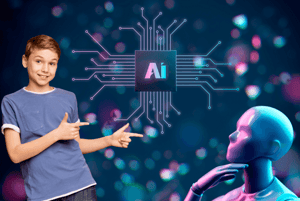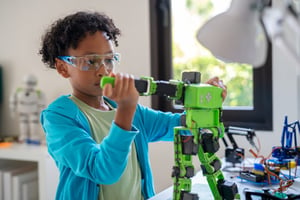Are you wondering how to explain artificial intelligence (AI) to your child? Maybe you’ve heard about AI in the news or noticed it being used in everyday apps and gadgets, but now your child is asking, “What is AI?” How do you even begin to answer that?
Don’t worry! This guide is here to help you introduce AI concepts to your kids in a way that’s fun, age-appropriate, and engaging. By the end of this article, you’ll not only know what AI is and why it’s important for your child’s future, but you’ll also have a toolkit of resources, activities, and ethical conversations to get them excited about learning more. Whether your child is 5 or 15, we’ll show you how to make AI understandable and exciting at every stage of their development.
Let’s dive into why teaching AI to kids is not just important—it’s essential.
Table of Contents
Why Teaching AI to Kids is Important
AI is shaping the world we live in, from the way we search for information to how businesses make decisions. For the next generation, understanding AI won’t just be an advantage—it will be a necessity. But why should parents start teaching AI concepts now?

First, introducing AI early helps children develop critical thinking and problem-solving skills. They begin to understand how technology works, how data drives decisions, and how machines can learn from patterns. This knowledge empowers kids to become creators, not just consumers, of technology.
Second, AI literacy opens up future career opportunities. From healthcare to entertainment, nearly every field is incorporating AI. Teaching kids the basics of AI today prepares them for tomorrow’s job market, where these skills will be in high demand. By starting early, you’re giving your child a head start in a field that will shape their future.
Related Read: Introduction to Artificial Intelligence for Kids: A Beginner’s Guide
Age-Appropriate AI Concepts
Introducing AI to kids requires age-appropriate explanations and activities. Each stage of development offers new ways to make learning about AI fun and accessible. Let’s break it down by age group to ensure your child learns in a way that’s engaging and understandable for them.
Early Elementary (Ages 5-7)
For younger kids, AI should be introduced through simple, relatable concepts. At this age, children can start by learning about machines and how they follow instructions. Explain that computers, just like robots in their favorite cartoons, can follow commands to do tasks, but they need people to teach them what to do.
Fun activities can include games where they “train” a toy or a simple program to recognize patterns, like sorting objects by color or shape. At this stage, focus on play-based learning, where kids learn that AI helps machines “think” and make choices based on the information we give them. Simple robot kits or apps designed for young children can make these ideas tangible and fun.
Related Read: Coding for 6 Year Olds – A Comprehensive Guide for Parents
Late Elementary (Ages 8-10)
In this age group, kids can start grasping the idea that AI is all about learning from data. You can explain that just like they learn from experiences—such as recognizing when something is hot or cold—machines can learn from patterns in data. They’ll enjoy activities that involve more interaction, like training a simple AI to recognize their voice or images.
Introduce them to block-based coding platforms, where they can visually understand how computers follow instructions. Projects like programming a robot to follow a line or respond to simple commands allow them to see AI in action. You can also start exploring basic coding and introduce terms like “algorithm” to show how AI makes decisions.
Related Read: Coding for 10-Year-Olds: A Comprehensive Guide for Parents
Middle School (Ages 11-13)
By middle school, kids are ready to dive deeper into how AI works. They can begin learning about concepts like machine learning, where computers get better at tasks through experience, similar to how humans improve by practicing. Discuss the types of problems AI can solve, such as recognizing faces or predicting weather patterns.
At this stage, encourage them to experiment with more complex coding platforms like Python, where they can create simple AI models. They can start building projects where an AI predicts something, like guessing which movie they might want to watch next based on their preferences. Introducing online AI tutorials or courses geared toward kids is a great way to keep their curiosity growing.
Related Read: Coding for 12 Year Olds – The Ultimate Guide
High School (Ages 14-18)
Teens are ready for a more detailed and practical understanding of AI. You can introduce advanced concepts such as neural networks, deep learning, and data science. High schoolers can explore the ethics of AI, discussing issues like privacy, bias, and the impact of AI on jobs and society.
Encourage them to work on projects where they apply AI to real-world problems, like using data to predict outcomes or even create their own AI chatbot. They can participate in AI competitions or hackathons to gain hands-on experience. Platforms like TensorFlow or AI-related internships can help them build skills that will serve them well in college or future careers in tech.
Related Read: Coding for 14-Year-Olds – The Ultimate 2024 Guide
Fun Tools and Resources to Teach AI to Kids
Teaching AI doesn’t have to be intimidating, especially with so many fun and engaging tools available for kids. Whether you’re looking for beginner-friendly apps or more advanced platforms, there’s something for every age group to explore.

For younger children, apps like Tynker and Scratch provide visual coding environments that make learning AI fun through drag-and-drop programming. Kids can create their own simple AI projects, like training a character to respond to voice commands or recognizing shapes in an image. Kodable is another great option that introduces AI concepts through playful activities designed for early learners.
As kids get older, they can start exploring platforms like Teachable Machine by Google, where they can train their own models using photos, sounds, or poses. For those who want to dive deeper, AI For Oceans by Code.org teaches machine learning through engaging games. High schoolers can take their skills further with resources like Kaggle or Microsoft’s AI for Good initiative, where they can tackle real-world challenges with AI.
Encouraging your child to explore these tools helps make learning AI a hands-on experience, reinforcing the concepts in a way that’s interactive and enjoyable.
Related Read: Top 10 Affordable AI Robots to Teach Kids Coding and AI
AI Ethics for Kids
As exciting as AI can be, it’s equally important to introduce children to the ethical implications of this technology. Kids should learn that AI, while powerful, is created by humans and can be influenced by the data it’s fed. Teaching ethics early helps children understand the importance of fairness, privacy, and accountability in AI development.
For younger children, start by discussing simple scenarios. Ask questions like, “Should a robot decide who wins a game?” or “Is it fair for a computer to only show us what it thinks we like?” These conversations help them think critically about the role of AI in everyday life.
For older kids, dive deeper into issues like bias in AI. You can explain how AI systems can sometimes make mistakes or unfair decisions because they were trained on biased data. Encourage them to think about how they can create more inclusive and fair technology. Discuss current topics like facial recognition, AI in social media, or how AI impacts jobs, helping them understand both the potential and responsibility that comes with creating AI.
Introducing these ethical considerations fosters a balanced view of AI and encourages kids to not only be creators but also thoughtful, responsible innovators.
Encouraging Curiosity and Exploration
One of the best ways to help your child learn about AI is to encourage their natural curiosity. Kids are born explorers, and AI offers a world of fascinating questions for them to dig into. Ask open-ended questions like, “How do you think a computer can recognize your face?” or “What do you think happens when a robot learns something new?” These discussions spark interest and invite your child to come up with their own ideas about how AI works.

Provide them with opportunities to experiment. Whether it’s building simple AI models, playing with AI-powered toys, or creating their own digital assistants, hands-on experience is key. Don’t be afraid to explore alongside them, even if you’re not an expert. By fostering a love for exploration, you’re not only helping them understand AI better but also fueling their passion for lifelong learning.
Remember, the goal is to keep the learning process fun and rewarding. Celebrate their efforts, even if things don’t always work perfectly. Curiosity leads to discovery, and AI is a perfect field for them to experiment, learn, and grow.
Related Read: Interactive AI Learning Tools for Kids: Apps and Platforms to Get Started
Conclusion: Start Your Child’s AI Journey Today
Introducing AI to kids is not just about preparing them for future careers; it’s about nurturing critical thinking, creativity, and curiosity in a world increasingly shaped by technology. From simple, playful activities for young children to more advanced coding and ethical discussions for teens, there are countless ways to make AI fun and engaging at any age.
As a parent, you don’t need to be an expert to help your child explore this exciting field. There are plenty of accessible tools and resources to guide both you and your child through the journey. And if you’re looking to take their learning further, check out the AI courses we offer at CodaKid. Designed specifically for kids, our courses combine fun, interactive lessons with real-world skills that will help your child thrive in a technology-driven future.
The future of AI starts with today’s learners, and your child could be the next great innovator. Let’s begin their adventure today!

















